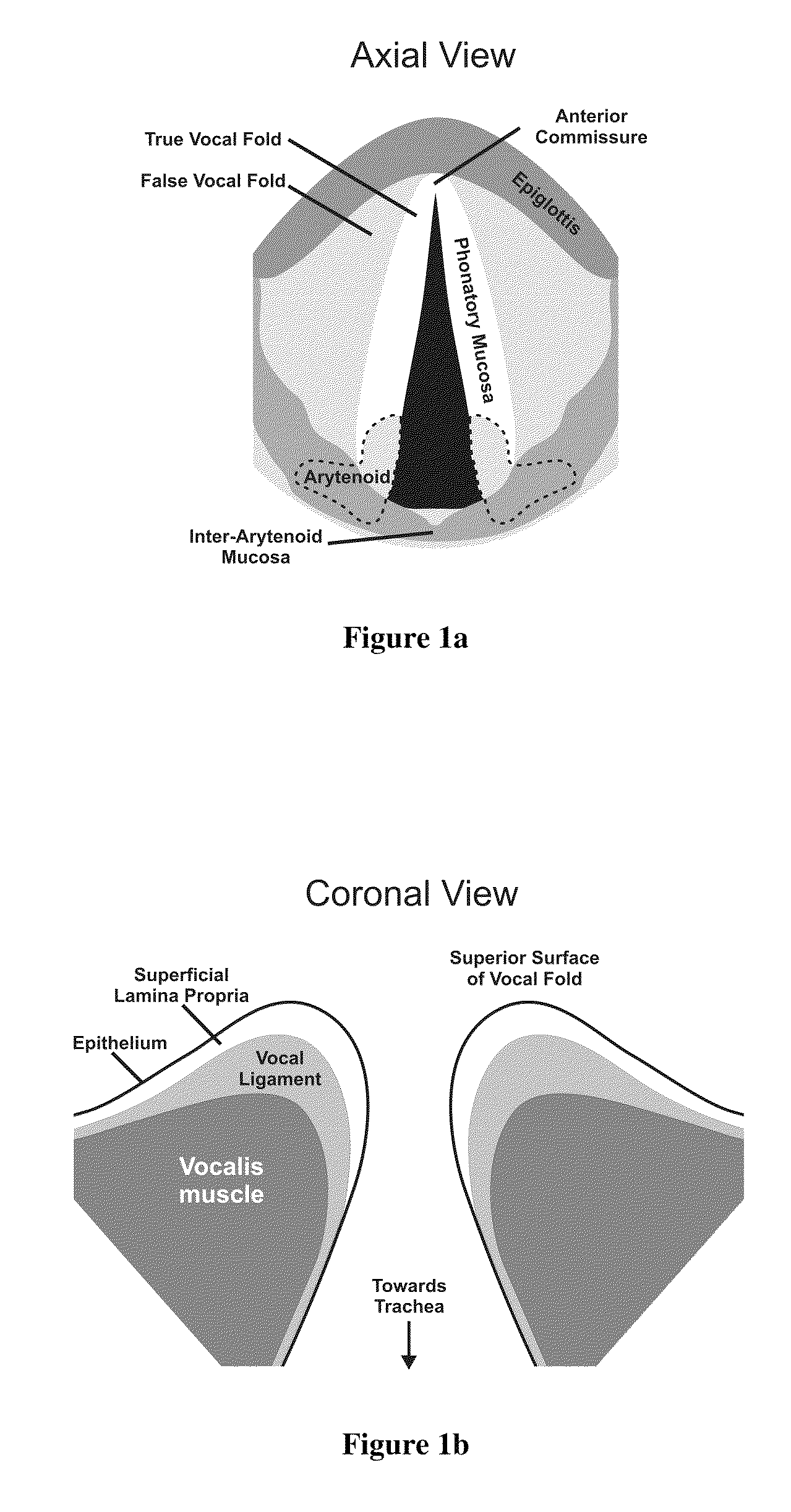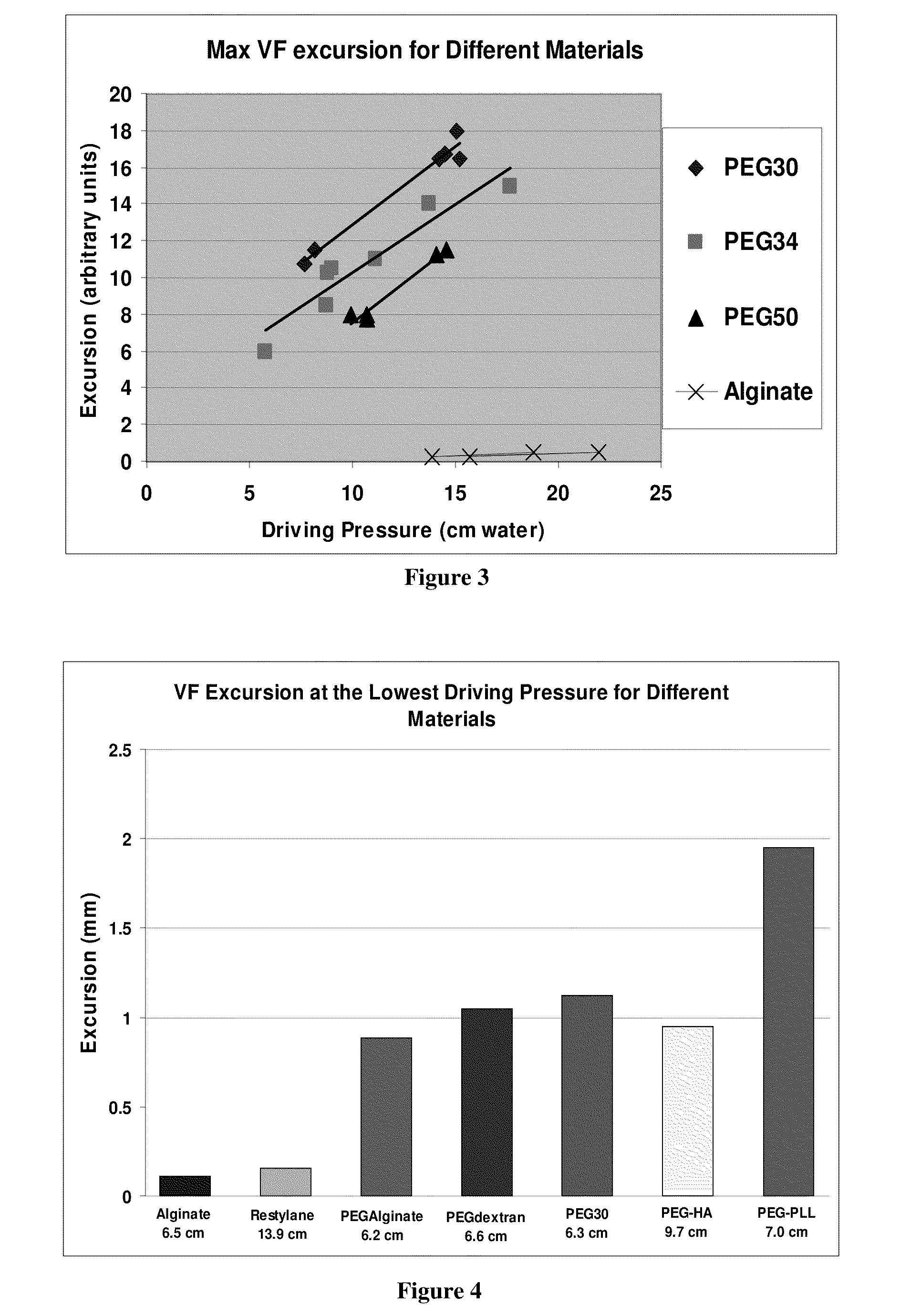Hydrogels for vocal cord and soft tissue augmentation and repair
a soft tissue and vocal cord technology, applied in the field of hydrogels for vocal cords and soft tissue augmentation and repair, can solve the problems of typically biocompatible hydrogels and not readily biodegradable, and achieve the effects of repairing the pliability of the phonatory mucosa of subjects, chronic hoarseness, and reducing functional vibratory capacity
- Summary
- Abstract
- Description
- Claims
- Application Information
AI Technical Summary
Problems solved by technology
Method used
Image
Examples
example 1
Preparation of Hydrogels for Injection into a Scarred Vocal Fold
[0088]Semi-interpenetrating networks technology was used to make the hydrogels of this Example. This process involves using a cross-linkable polymer (X) that is polymerized in the presence of a non-crosslinkable polymer (Y). The physicochemical properties of the gels were controlled by independently varying i) the fraction (f) of X in the solution; ii) the concentrations (CX and CY) of the components; and iii) the molecular weights (MX and MY) of the components of the hydrogel. All the polymers used to form the hydrogels in this Example were water-soluble. Photopolymerization using UV light (centered at 365 nm) was carried out using Irgacure 2959 (Ciba Specialty Chemicals, Tarrytown, N.Y.) as the photoinitiator. The description given below outlines the detailed protocol for preparing certain exemplary hydrogels where,
[0089]X=Polyethylene Glycol Diacrylate (PEG-DA) obtained from SunBio Inc.
[0090]Y=Polyethylene Glycol (PE...
example 2
Demonstration of the Efficacy of Hydrogels in Repairing the Pliability of the Phonatory Mucosa Using Ex Vivo Models
[0128]Cow Larynx Model.
[0129]An ex vivo bovine larynx model was used to the evaluate effects of gel stiffness on mucosal wave amplitude, as a measure of vocal fold pliability. Adult cow cadaver larynges were prepared by cutting a 1 cm by 3 cm window in the thyroid lamina and then removing a block of the thyroarytenoid muscle to expose the deep surface of the vocal ligament, a layer of collagenous tissue between the SLP and the thyroarytenoid muscle. The ligament was opened with microscissors and the soft contents of the lamina propria were carefully removed over the entire extent of the vocal fold, leaving only the thin and transparent epithelium with minimal attached SLP. The test materials were layered behind the epithelium in volumes equal to the volume of the removed lamina propria (˜0.25 ml), resulting in a layer of gel 2-3 mm thick. An oval piece of stiff latex sh...
example 3
Demonstration of Safety and Efficacy of PEG30 in an In Vivo Model
[0134]Testing in Canines.
[0135]PEG30 was injected unilaterally in sixteen normal canine VFs with post-injection survival periods of 1, 2, 3, and 4 months (n=4 / time point). An average of 60 μL of PEG30 was injected in the VF. We made periodic examinations of VF appearance and in vivo function using methods developed at the MGH Center for Laryngeal Surgery and Voice Rehabilitation. Stroboscopic and high speed videos of the VF vibration (4000 frames / sec) were recorded during these exams while using a tracheal needle to inject air for phonation. These recordings allow us to assess the pliability of the VFs under physiological conditions. High resolution MRI and histology were performed on the excised larynges after euthanasia to identify the location of the PEG30 in the VF and to observe tissue responses to the injected material.
[0136]Ability of PEG30 to Maintain the Pliability of Vocal Folds In Vivo.
[0137]As a measure of ...
PUM
| Property | Measurement | Unit |
|---|---|---|
| frequency | aaaaa | aaaaa |
| elastic shear modulus | aaaaa | aaaaa |
| elastic shear modulus | aaaaa | aaaaa |
Abstract
Description
Claims
Application Information
 Login to View More
Login to View More - R&D
- Intellectual Property
- Life Sciences
- Materials
- Tech Scout
- Unparalleled Data Quality
- Higher Quality Content
- 60% Fewer Hallucinations
Browse by: Latest US Patents, China's latest patents, Technical Efficacy Thesaurus, Application Domain, Technology Topic, Popular Technical Reports.
© 2025 PatSnap. All rights reserved.Legal|Privacy policy|Modern Slavery Act Transparency Statement|Sitemap|About US| Contact US: help@patsnap.com



